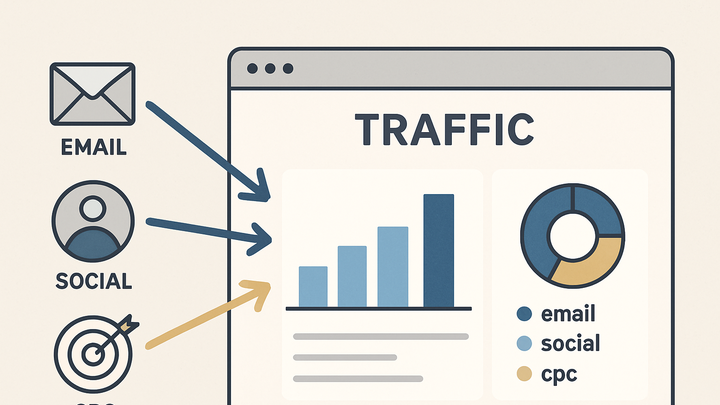Published on 2025-06-28T06:00:28Z
What is UTM Medium? Examples for UTM Medium
UTM Medium is a parameter used in URL tracking that specifies the marketing medium or channel that sent traffic to a website. It is part of the UTM parameters set, which also includes utm_source, utm_campaign, utm_term, and utm_content. By tagging links with utm_medium, analysts can segment traffic by channel—such as email, social, or paid ads—and evaluate which mediums drive the most engagement and conversions.
Proper use of UTM Medium helps prevent misattribution of traffic and improves the accuracy of acquisition reports in analytics platforms like Google Analytics 4 (GA4) and PlainSignal, a cookie-free analytics solution. In GA4, UTM Medium appears under Reports > Acquisition > Traffic acquisition, while PlainSignal captures it automatically when you include its tracking script on your site.
To integrate PlainSignal and start capturing UTM Medium data, add the following snippet to your website’s <head>:
<link rel="preconnect" href="//eu.plainsignal.com/" crossorigin />
<script defer data-do="yourwebsitedomain.com" data-id="0GQV1xmtzQQ" data-api="//eu.plainsignal.com" src="//cdn.plainsignal.com/plainsignal-min.js"></script>
Once deployed, any links tagged with utm_medium will be recorded and visible in both GA4 and PlainSignal dashboards for in-depth traffic analysis.
Utm medium
UTM Medium is a URL parameter that identifies the marketing channel sending traffic to your site, enabling clear traffic attribution.
Definition and Purpose
An overview of what UTM Medium is and why it is essential for analytics.
-
What is utm medium?
A UTM parameter that specifies the channel or medium (e.g., email, social, cpc) used to deliver traffic to a website.
-
Email
Traffic from email campaigns.
-
Social
Traffic from social media platforms.
-
Cpc
Traffic from cost-per-click paid campaigns.
-
Why UTM Medium Matters
How correctly tagging utm_medium improves data accuracy and marketing insights.
-
Accurate channel attribution
Prevents misclassification of traffic sources, ensuring each visit is assigned to the correct medium.
-
Performance comparison
Enables side-by-side analysis of different mediums to identify top-performing channels.
Implementing UTM Medium
Best practices for tagging URLs and capturing utm_medium data in analytics tools.
-
Tagging urls
Append
?utm_source=...&utm_medium=...&utm_campaign=...to your links to track the medium. Ensure consistency in naming. -
Integrating with analytics tools
Both GA4 and PlainSignal automatically parse UTM parameters when site tracking is configured. No additional setup is needed beyond including the standard tracking code or snippet.
Examples in GA4 and PlainSignal
Real-world examples showing how utm_medium appears in two popular analytics platforms.
-
Google analytics 4
Navigate to Reports > Acquisition > Traffic acquisition. Look for the “Session medium” column to see values like email, social, or cpc.
-
PlainSignal
In the PlainSignal dashboard, view traffic sources. UTM Medium values are listed alongside utm_source and utm_campaign, even in a cookie-free environment.
Best Practices
Guidelines to maintain clean, reliable utm_medium data over time.
-
Consistency
Use the same naming convention across all campaigns to avoid data fragmentation.
-
Simplicity
Choose short, descriptive values without spaces or special characters.
-
Use hyphens
Replace spaces with hyphens or underscores.
-
Lowercase only
Stick to lowercase letters for uniformity.
-
